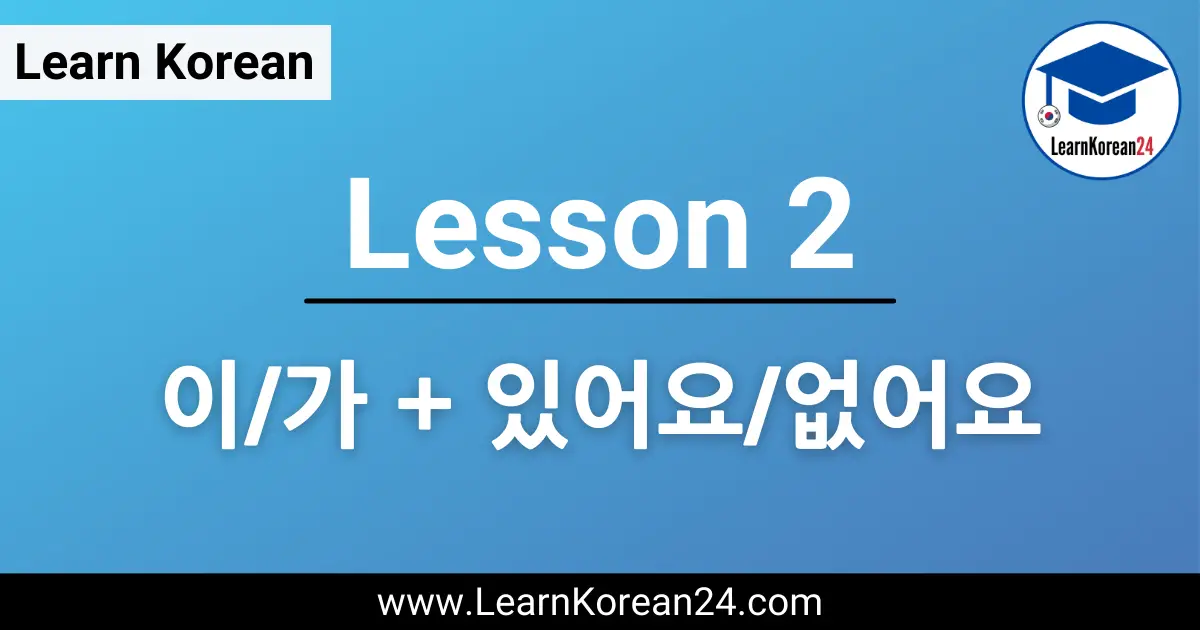Lesson 2: 이/가 + 있어요/없어요
In this lesson, you will learn how to use the pattern 이/가 + 있어요/없어요 to say things like “There is (something).“, “There isn’t (something).”, “I have (something).“, “I don’t have (something).“.
Lesson 2:
이/가 + 있어요/없어요
KEY INFORMATION
있어요 [i-sseo-yo] = Ending which means ‘there is’ or ‘have’.
없어요 [eop-seo-yo] = Ending which means ‘there isn’t’ or ‘don’t have’.
이/가 [i/ga] = Subject Marking Particle
있어요 [i-sseo-yo] = there is/have
First, let’s take a look at the ending 있어요 [i-sseo-yo]. 있어요 comes from the verb 있다 [it-da] which means ‘to exist’. In the present tense 있다 [it-da] becomes 있어요 [i-sseo-yo] and can mean ‘there is’ and ‘have’. You’ll learn how to form the present tense in a future lesson, but for now, just remember that 있어요 means ‘there is’ or ‘have’. To help you understand what we mean, let’s look at some examples.
물이 있어요? [mu-ri i-sseo-yo] = Is there water? / Do you have water?
물이 있어요. [mu-ri i-sseo-yo] = There is water. / I have water.
사과가 있어요? [sa-gwa-ga i-sseo-yo] = Is there an apple? / Do you have an apple?
사과가 있어요. [sa-gwa-ga i-sseo-yo] = There is an apple. / I have an apple.
As you can see, 있어요 can be used in both statements and questions. To make a question, all you need to do is raise your intonation at the end of the word.
없어요 [eop-seo-yo] = there isn’t/don’t have
없어요 [eop-seo-yo] is the opposite of 있어요 [i-sseo-yo]. It comes from the verb 없다 [eop-da] which means ‘to not exist’. In the present tense, 없다 [eop-da] becomes 없어요 [eop-seo-yo] and means ‘there is not’ or ‘don’t have’. Here are some examples:
물이 있어요? [mu-ri i-sseo-yo] = Is there water? / Do you have water?
물이 없어요. [mu-ri eop-seo-yo] = There isn’t water. / I don’t have water.
사과가 있어요? [sa-gwa-ga i-sseo-yo] = Is there an apple? / Do you have an apple?
사과가 없어요. [sa-gwa-ga eop-seo-yo] = There isn’t an apple. / I don’t have an apple.
이/가 [i/ga] = Subject Marking Particle
In the previous lesson, you learned that 은/는 [eun/neun] is a particle used to mark the topic of a sentence. Another Korean particle is 이/가 [i/ga]. 이/가 [i/ga] is what is known as a ‘subject marking particle’. It is used to mark the subject of a sentence.
The subject of a sentence is the person or thing that is doing the verb, or, in the case of adjectives, the person or thing being described. For example, in the sentence 물이 있어요 [mu-ri i-sseo-yo] 물 (water) is marked with the subject marking particle 이 because it is the thing that is doing the verb (the verb being 있어요 = exist).
In a future lesson, you will learn how to use 이/가 together with adjectives, but in this lesson, we will just focus on using 이/가 together with the verbs 있어요 (to exist) and 없어요 (to not exist).
*The concept of Korean particles can be difficult for beginner learners, so don’t worry too much about mastering them right now. Over time, as you learn more and more Korean, the usage of Korean particles will become more natural. For now, just remember that attaching 이 or 가 to a person or thing is used to mark the subject of a sentence.
이/가 Conjugation Rule
When attaching 이 or 가 to a word, you must choose the correct one. The one you choose depends on whether the preceding noun ends in a consonant or a vowel. You can find the conjugation rules in the table below.
| Conjugation Rule | Examples |
|---|---|
| Noun Ending In Consonant + 이 | 물이 (water) |
| Noun Ending In Vowel + 가 | 사과가 (apple) |
Example Sentences
To review, here are some more example sentences using the structure 이/가 + 있어요/없어요. If you want to try and make your own sentences using this structure, check out our Korean Vocabulary Lessons to find some words you can use as the subject of the sentence.
A: 책이 있어요? [chae-gi i-sseo-yo] = Is there a book? / Do you have a book?
B: 네, 책이 있어요. [ne, chae-gi i-sseo-yo] = Yes, there is a book. / Yes, I have a book.
A: 모자가 있어요? [mo-ja-ga i-sseo-yo] = Is there a hat? / Do you have a hat?
B: 아니요, 모자가 없어요. [a-ni-yo, mo-ja-ga eop-seo-yo] = No, there isn’t a hat. / No, I don’t have a hat.


